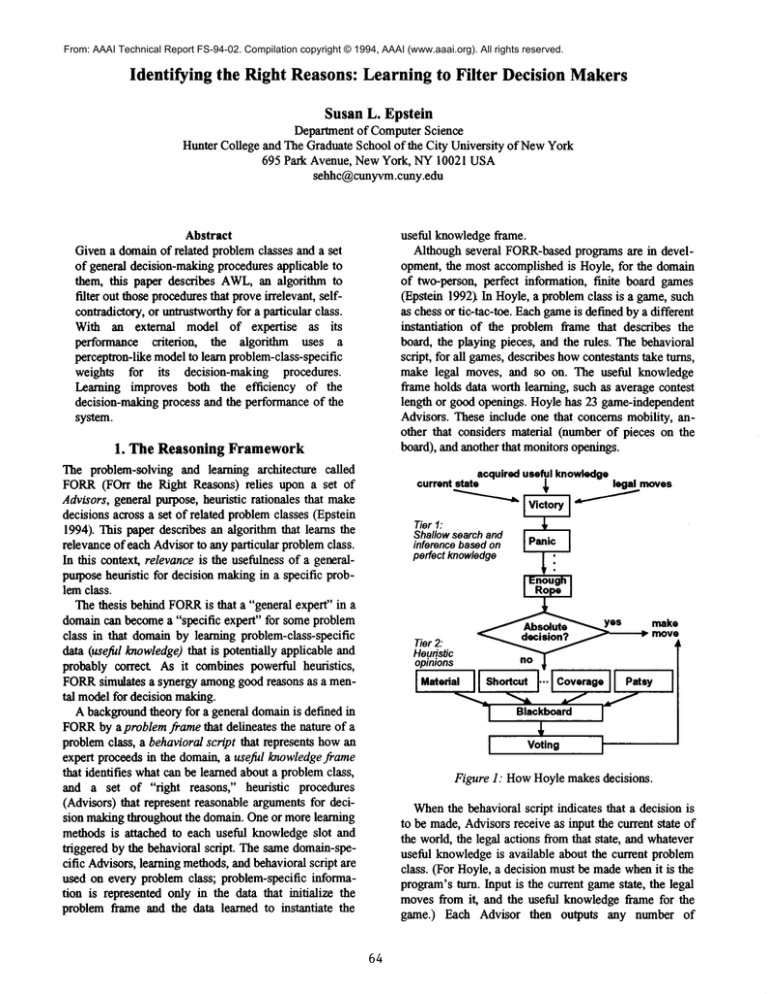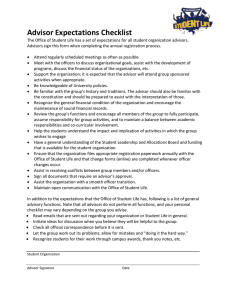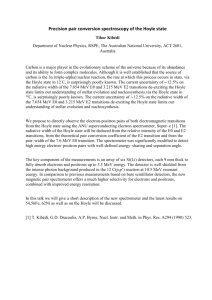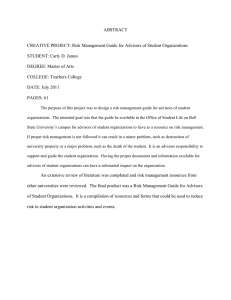
From: AAAI Technical Report FS-94-02. Compilation copyright © 1994, AAAI (www.aaai.org). All rights reserved.
Identifying the Right Reasons: Learning to Filter Decision Makers
SusanL. Epstein
Department of ComputerScience
Hunter College and The Graduate School of the City University of NewYork
695 Park Avenue, NewYork, NY10021 USA
sehhc@cunyvm.cuny.edu
useful knowledgeframe.
Although several FORR-basedprograms are in development, the most accomplished is Hoyle, for the domain
of two-person, perfect information, finite board games
(Epstein 1992~In Hoyle, a problemclass is a game, such
as chess or tic-tac-toe. Eachgameis defined by a different
instantiation of the problem flame that describes the
board, the playing pieces, and the rules. The behavioral
script, for all games,describes howcontestants take turns,
make legal moves, and so on. The useful knowledge
frame holds data worth learning, such as average contest
length or good openings. Hoyle has 23 game-independent
Advisors. These include one that concerns mobility, another that considers material (number of pieces on the
board), and another that monitors openings.
Abstract
Given a domainof related problemclasses and a set
of general decision-making procedures applicable to
them, this paper describes AWL,an algorithm to
filter out those proceduresthat proveirrelevant, selfcontradictory, or untrustworthyfor a particular class.
With an external model of expertise as its
performance criterion,
the algorithm uses a
perceptron-like modelto learn problem-class-specific
weights for its decision-making procedures.
Learning improves both the efficiency of the
decision-making process and the performance of the
system.
1. The ReasoningFramework
The problem-solving and learning architecture called
FORR(FOrr the Right Reasons) relies upon a set
Advisors, general purpose, heuristic rationales that make
decisions across a set of related problemclasses (Epstein
1994). This paper describes an algorithm that learns the
relevance of each Advisorto any particular problemclass.
In this context, relevance is the usefulness of a generalpropose heuristic for decision makingin a specific problena class.
The thesis behind FORR
is that a "general expert" in a
domaincan becomea "specific expert" for someproblem
class in that domainby learning problem-class-specific
data (useful knowledge)that is potentially applicable and
probably correct As it combines powerful heuristics,
FORRsimulates a synergy amonggood reasons as a mental modelfor decision making.
A backgroundtheory for a general domainis defined in
FORR
by aproblem frame that delineates the nature of a
problemclass, a behavioral script that represents howan
expert proceeds in the domain, a useful knowledgeframe
that identifies what can be learned about a problemclass,
and a set of "right reasons," heuristic procedures
(Advisors) that represent reasonable arguments for decision makingthroughout the domain. One or more learning
methods is attached to each useful knowledgeslot and
triggered by the behavioral script. The same domain-specific Advisors, learning methods,and behavioral script are
used on every problem class; problem-specific information is represented only in the data that initialize the
problem frame and the data learned to instantiate the
acquireduseful knowledge
currentstate
legal moves
Tier1:
Shallowsearchand
inferencebasedon
perfect knowledge
,p
opinions
no
I-’-’II Sho.==t
I’"lC°"r"
II
4,
f
t
Figure 1: HowHoyle makes decisions.
Whenthe behavioral script indicates that a decision is
to be made, Advisorsreceive as input the current state of
the world, the legal actions from that state, and whatever
useful knowledgeis available about the current problem
class. (For Hoyle, a decision must be madewhenit is the
program’sturn. Input is the current gamestate, the legal
movesfrom it, and the useful knowledgeframe for the
game.) Each Advisor then outputs any number of
64
commentsthat support or discourage an action. A
comment
lists the Advisor’sname,the action commented
upon, and a strength, an integer from 0 to l0 that
measuresthe intensity and direction of the Advisor’s
opinion.
Asthe schematicof Figure1 indicates, all Advisorsare
not createdequal. Someare alwaysperfectly correct, take
precedenceover others, and mayhave the authority to
makea decisionunilaterally or to eliminatea legal action
fromanyfurther consideration.Initially, Hoylealwaysattemptsdecisionsin its first tier of sevensuchAdvisors.
These include one that movesto win immediately, and
another that re fuses to makea losing move.Onlywhen
the first tier fails to makea decisiondoescontroldefault
to the 17 Advisorsin Hoyle’ssecondtier.
Second-tierAdvisorsare not necessarily independent,
or evencorrect in the full contextof the state space.Each
of themepitomizesa heuristic, specializedviewof reality
that can makea valid argument
for or against oneor more
actions. All of themhavea resource-limitedopportunity
to comment
before any decision is made.It is here that
relevance, internal consistency,and trustworthinessbecomeissues, and that the AWL(AdvisorWeightLearning)
algorithmis based.
A FORR-basedprogram improves its performance
withina specific problemclass as it learns useful knowledgeandthenapplies it as input to the Advisors.Advisors
do not learn, but they do makebetter decisionswhentheir
input improves.Since they epitomizemanydifferent ways
to reason in a broad domain,however,the Advisorsmay
not alwaysprovideconsmactive
informationwithin a specific problemclass. WhatFORR
did not do, prior to this
paper, is learn whichAdvisorsto consultwhen.
As wehave challenged Hoylewith increasingly more
difficult games, we have incorporated several new
Advisors. Althoughthese Advisors were essential to
Hoyle’sability to learn to play someof these newgames
well, they werealso irrelevant to someof the early games
Hoylehad already learned. Tests indicated that, while
these newAdvisorsdid not degradeHoyle’sability to
learn to play extremelywell, they did slowits decisionmakinglime whenthey were given the opportunity to
comment.In the newerand moredifficult games,more
complexissues arose. SomeAdvisorsregularly contradicted themselves,andothers wereactually a hindranceto
learning, i.e., Hoylecouldlearn to play expertlyonly if
they werenot present. Hoyleneededto learn about relevance.
2. Learning about Relevance
Prior to AWL,
a decision in the secondtier wasmadeby
tallying the Advisors’comments
on each legal action with
their strengths. The action madewas the one with the
strongestsupport:
maxi(~Acomment
strength fromAdvisorAon action il)
65
For example,given comments:
< Advisor-1,action-1, 6 >
< Advisor-1,action-2, 8 >
< Advisor-2,action-l, 7 >
< Advisor-3,action-3, 8 >
action-2 andaction-3 each only havesupport8, while action-1 has support 13 and will be executed.This is because the comments
havestrengths (6, 8, 7, 8, respectively) but the Advisorsdo not haveweights, i.e., an 8
fromone Advisoris just like an 8 from another. In the
preceding example,however,if Advisor-3had weight 2
andthe others hadweight1, then action-3 wouldhavehad
support 16 and have beenexecutedinstead. AWL,
the algorithmthat learns weightsfor second-tierAdvisors,was
devisedto exploit empiricalevidencethat the accuracyof
eachsecond-tier Advisorindeedvaried with the game.
For each game, AWL
is expected, based uponexperience, gradually to reduce the weightsof irrelevant and
self-contradictory Advisorsto 0, and to increase the
weightsof the morereliable Advisorsbeyondthose of the
less reliable ones. AWL
executes after every contest
Hoyleplays again.qt an external (humanor computer)expert. Thealgorithmconsiders, oneat a time, only those
states in whichit was the expert’s turn to moveand
Hoyle’sfirst tier wouldnot have madea decision. For
each such state, AWL
tallies the first valid statement
amongthe followingfvalues:
fl: the Advisorsupportsthe expert’s recordedmove
f2: the Advisordoesnot supportthe expert’s moveand
supports another move
f3: the Advisoropposesthe expert’s move
f4: the Advisordoesnot opposethe expert’s moveand
opposes another move
Essentially, AWL
fits Hoyleto the expert, learning to
whatextent each of its Advisorssimulates expertise as
exemplifiedby the expert’s moves.Thelearned weights
are a modificationof Littlestone’s perceptron-likealgorithm(Littlestone1988).Theweightfor Advisori
!
where
ai=l, cij
v
= fl, and cij =f3
If weightswereupdatedduringthe play of the contest, j
wouldbe the state. BecauseHoyleplays in real time and
updatingthe weightsduring play wouldslowit downconsiderably, wechose instead to "massively update" the
weightsduringthe poslmortem
at the endof each contest
wheremuchof the other learning occurs.
3. Applying the Learned Weights
TheAdvisors’weightsserve as the criterion for adapting
the decision-making
processin three different ways.
¯ Weights identify irrelevant Advisors. AnyAdvisor
whosef values all remainat 0 has madeno comments
at
all and, after sometime, can be eliminated.For example,
the Advisorthat calculates strength baseduponhowmany
pieceseachcontestanthas onthe boardis irrelevantin tictac-toe.
¯ Weights identify self-contradictory Advisors. In some
games, the same movesconsistently and simultaneously
look both good and bad to aa Advisor. For example, in
tic-tac-toe one Advisor will support every legal movebecause it reduces the numberof options for the other contestant on its next turn, and oppose the same movewith
the same strength because it reduces Hoyle’s ownoptions
on its next turn. (In other games this Advisor behaves
quite differently and is extremelyconstructive.) Whenfl
= f3, an Advisor is self-contradictory and, after some
time, can be eliminated.
¯ Weights identify untrustworthy Advisors. Althoughsome
weights will "look better" than others, AWL
uses an absolute standard rather than a relative one. For this purpose,
we introduced a dummyadvisor called Anything that
makes comments with random strengths. Because some
Advisors makemore conmtents than others and Anything
is intended as a general benchmark,Anythin.g makesi > 0
commentsfor each state with probability 2-z. The Advisor
Anything serves as benchmarkfor random opinion; it is
not consulted when Hoyle plays, only whenthe algorithm
learns weights after the contest is over. An Advisorthat
consistently underperforms Anything is untrustworthy
and, after sometime, can be eliminated.
learning experiences are identical. Therefore results are
monitoredover a set of runs.
5. Results
Severalvalues weretried for ct on tic-tac-toe, lose tic-tactoe, and five men’smorris: 1.2, 1.1, 1.05, 1.02, and finally
1.01. The larger values narrowedHoyle’s learning experience too fast; during testing the programthen performed
less well again,~t the weaker challengers than without
weight learning. This is because, with larger ct’s, the
weights were fitted so quickly that Hoyle had no time to
acquire other items of useful knowledgethat required
more playing experience but wouldstand it in good stead
against weakercompetitionduring testing.
AWL
offered the following advantages in learning:
¯ Hoyle’s reaction time improved when irrelevant
Advisors were eliminated, without any increase in the
numberof contests required to learn or any degradation of
the program’s ability to play. Hoyle with AWL
learns to
play tic-tac-toe in just as few contests and learns to play
just as well as without AWL.With AWL,however, the
program also eliminates manyAdvisors it would otherwise consult, so that Hoyle with AWLnowplays perfect
tic-tac-toe morequickly.
¯ Hoyle learned some gamesfaster and morereliably, losing less frequently to the less skilled challengers. Losetim
tac-toe has a fairly small state space (5478) but is nontrivial for Hoyle to learn. With AWL,Hoyle not only
learns to play the gamefaster, it also learns to play it more
reliably, losing less frequently to the less skilled challengers.
¯ Hoyle could identify and eliminate Advisors that made
learning impossible (by offering powerful but incorrect
advice) without forcing them to be discarded for other
games. Althoughan Advisor called Shortcut is necessary
to learn nine men’s morris, Shortcut makes learning a
somewhateasier game, five men’s morris, impossible,
i.e., the runs do not achieve 10 consecutive draws even
after several linndred contests. WithAWL,however,after
10 contests Hoyle is able to identify Shortcut as worse
than Anything,eliminate it, and go on to learn to play the
game extremely well. In nine men’s morris, Hoyle with
AWL
does not eliminate Shortcut and goes on to learn to
play that quite well too.
4. ExperimentalDesign
AWL
has been tested with Hoyle on tic-tac-toe, lose tictat-toe (playedexactly like tic-tac-toe exceptthat the first
contestant to achieve three of the same playing piece
along a row, column, or diagonal loses), and somemorris
games. A morris game has two contestants, black and
white, each with an equal numberof playing pieces. The
morris boards vary from one gameto the next; they are
characterized by concentric squares connected with intersecting lines. Playing pieces can be located at the intersection of any pair of lines. In five men’smorris, for example, each contestant has five playing pieces and there are
16 possible locations for the playing pieces. Eachmorris
contest has twostages: a placing stage, whereinitially the
board is empty, and the contestants alternate placing one
of their playing pieces on any empty position, and a
sliding stage, where a turn consists of sliding one’s
playing piece along any line drawnon the gameboard to
aa immediately adjacent empty position. Morris games
offer substantial challeages: five men’smorris has about
nine million states in its search space, nine men’sabout
143billion.
For the AWLruns described here, Hoyle learned to
play a specific gameagainst an external expert until it
achieved 10 consecutive draws. At that point learning was
turned off, and Hoyle was tested in a tournament of 20
contests against each of four challengers:a perfect player,
an expert, a novice, and a random player at the same
game. The same ct value was used for all Advisors.
Becausethe external expert chooses against equally valid
movesat random, and so does Hoyle’s second tier, no two
6. Discussion
The phrase "after sometime [an Advisor] can be eliminated" runs throughout Section 3. For now, Hoyle pauses
every 10 contests to report its weights and to ask permission to eliminate Advisorsbecausethey are self-contradictory or nntrustwortliy. This is an anomalyin a previouslyautonomous discovery program, but when to take dramarie action based upon the weights themselves is a real
concern. Usually Hoyle’s judgments are accurate, but occasionally
an Advisor is prematurely labeled
’Mntrustworthy" and, after more experience, Hoyle would
66
not have attempted to eliminate it. (One example is
Hoyl¢’s occasional overeagemessin lose tic-tac-toe to
discard the Advisor that considers openings because of
what appears to be initially poor performance. The real
problem is that the opening Advisor needs more useful
knowledgethan has yet been acquired; once that knowledge is in place it performsquite well.) For now,we have
selectively refused permission to discard Advisors, and
have observed that Hoyleeventually chooses to retain the
right ones. If we increase the parameter 10, however,
~
manyirrelevant Advisors will continue to slow the real
time devoted to play, and some incorrect Advisors may
continue to delay learning. Weare nowexploring a variety of methodsto establish the correct balance between
efficiency and overeagerness.
For Hoyle, AWLactually uses two new useful knowledge slots for each game: one for weights in the placing
stage and one for the weightsin the sliding stage. In this
domainthe change in the rules makesthe stage boundary
obvious. In another domain, or even in more complex
games, there might be more than two kinds of problem
solving (here, the placing and sliding stages) that merit
individually tabulated sets of weights. The weights identify how the Advisors’ performance differs between
stages, but as yet we have no code to detect such stages,
and believe that to be a non-trivial task.
In moredifficult domainsor problemclasses, the external expert will not performperfectly. (There is, for example, no perfect-playing expert program for nine men’s
morris.) Weight-learning there would attempt to fit
Hoyle’s decision makingto that of an imperfect, although
strong, expert, with unpredictable results. Andhowwould
one learn weights in a domainwithout an expert model?If
Hoyle were to learn weights while playing again~ itself,
for example,the early contests wouldbe entirely untrustworthy. (Whenone poor player beats another, there is
likely to be little worth imitating.) Perhaps ~ should be
treated like the temperature in simulated annealing, but
increase over time or with improvedperformance, to reflect the algorithm’s increasing confidence in its own
judgment.
A recent application of AWL
is for the validation of
pattern-based Advisors in a new, game-dependentthird
tier (Epstein, Gelfand, & Lesniak submitted). These
Advisorsare generalizations of persistent patterns with a
single, consistent association. Althoughthey are based
uponexperience in play, they are inductive guesses whose
67
reliability and relevance merit close examination. AWL
has provedan able filter for them. It strengthens
the most
important, eliminates the irrelevant, and disregards the incorrect ones.
Wecontinue to refine AWL.The f2 and f4 values
should be put to use. The weights also provide us with a
clear metric on Advisorperformancethat could be helpful
in the design and testing of new Advisors. Finally, AWL
is under study with FOR_R-based
programs in additional
domains.
7. Conclusion
Advisors in FORR
are broad, general theories about how
to performwell in a domainof related problemclasses. In
any specific problemclass, somewill prove more relevant
than others. Advisor weights are only one item of useful
knowledge,however. It is important to allow the program
enoughtime to learn other items that serve as input to the
Advisors and allow them to makea strong contribution.
With a good choice for ~ the AWL
algorithm speeds and
improves the quality of FORR-based
learning. Given a set
of good reasons for makinga decision in a broad domain,
AWL
quickly detects those that are irrelevant, self-contradictory,
or ~orthy in a segment of the domain.
Whenthe decision makers are filtered this way, a FORRbased programcan learn the relevance of its heuristics and
learn to performmoreefficiently and moreaccurately.
References
Epstein, S. L. 1992. Prior Knowledge Strengthens
Learning to Control Search in WeakTheoryDomains.
International Journal of Intelligent Systems, 7: 547586.
Epstein, S. L. (1994). For the Right Reasons: The FORR
Architecture for Learning in a Skill Domain.Cognitive
Science, 18(3).
Epstein, S. L., Gelfand, J. &Lesniak, J. (Submitted). The
Integration of Pattem-Based Learning and SpatiallyOriented Reasoning with a Multi-Agent, DecisionMakingExpert.
Littlestone, N. (1988). Learning Quickly whenIrrelevant
Attribntes Abound:A NewLinear-threshold Algorithm.
MachineLearning, 2, 285-318.




